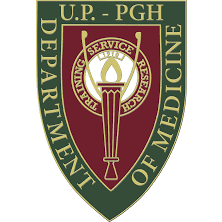About
Mission Vision

Vision
To attain excellence and relevance in Internal Medicine and its specialties through the implementation of quality programs in primary and tertiary levels of service, training and research.
Mission
By 2025, the Filipino people shall be served by ethical health professionals from the Department of Medicine, who shall be globally competitive through excellence and leadership in service, training, and research.
History of UP-PGH Department of Medicine
The Department Takes Shape
In 1907, the department of medicine was established as a teaching, service, and research section of the Philippine Medical School. When the University of the Philippines was created in 1908, this medical school became the UP College of Medicine. The first chairman of the department was Dr. William Musgrave, an expert in tropical diseases.
During this period, the towering figure in Philippine medicine was Dr. Antonio G. Sison who became chairman and, subsequently, dean of the college, director of the hospital and, for a while, president of the university. His staunch heroism preserved the hospital and the lives of the doctors and patients during the Japanese Occupation. Best remembered for bringing medical pedagogy to the bedside, Dr. A.G. Sison taught the students to diagnose using all their senses.
Birth of the Subspecialties
After the war, the rehabilitation of the department was paramount. This task fell largely on the shoulders of Dr. Agerico BM Sison, nephew of the former dean. ABM, the master physician, would mesmerize the residents and students with his astuteness at diagnosis, using only history and physical examination and the barest of laboratory findings. With help of the China Medical Board of New York, a new generation of Filipino physicians was sent to the US to renew the advancement of medical knowledge that was disrupted by the war.
Dr. Paulo Campos would take over in the 1960s and spearhead the building of laboratories, which would nurture the rise of subspecialties such as endocrinology, nuclear medicine, hematology, and pulmonary medicine.
The Rise of Medical Research
In the 1970s, Dr. Andres Reyes would become chairman as the subspecialties blossomed with the introduction of unique procedures; cardiac catheterization and open-heart surgery in cardiology; endoscopy in gastroenterology; spirometry and plethysmography in pulmonary medicine; hemodialysis in nephrology. The intensive care and coronary units came into being as well. With the creation of the clinical epidemiology unit, Dr. Ernesto Domingo would bring the department into a new era of evidence-based medicine in the early 1980s. Innovative programs such as straight internship and straight residency would also be introduced.
Embracing the Modern Age
Dr. Yolando Sulit would take over as chairman and send fellows abroad to train in interventional cardiology. Construction of the PGH central block would be disrupted by the eviction of the Marcoses by the “people power” revolution in February 1986. Construction would eventually be completed during the term of Dr. Antonio Gonzaga, as the Japanese government donated a new dispensary building. In the mid-1990s, Dr. Clemente Amante would preside over the crafting of the department’s mission vision and the groundwork for fortifying undergraduate medical education. The Sagip Buhay Drug Bank would evolve into a foundation to help defray the cost of treating indigent patients, and a new cardiac catheterization laboratory would be inaugurated.
The Department Enters the New Millennium
The new millennium would see two women physicians on the role of department chairperson. Dr. Mediadora Saniel and Dr. Agnes Mejia would build on the groundwork laid by Dr. Amante in strengthening undergraduate medical training and lead the department into give consecutive silver cup awards as the best clinical department in the college. The Sagip Buhay Medical Foundation would venture into new fund-raising activities in the drive to ensure the financial sustainability of programs for patient care, maintenance of physical plant, and the training of medical fellows. – Hands, Hearts & Minds: 100 Years of the UP-PGH Department of Medicine
